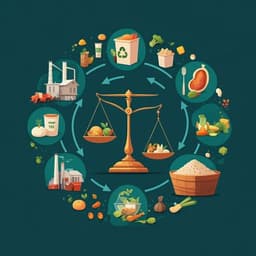
Engineering and Technology
Emission impacts of China's solid waste import ban and COVID-19 in the copper supply chain
J. Ryter, X. Fu, et al.
This study investigates how the copper supply chain responds to China's solid waste import ban and the impacts of the COVID-19 pandemic. The research reveals that the ban has unintended environmental consequences, increasing CO2 emissions, while refined copper imports could mitigate this effect. Conducted by John Ryter, Xinkai Fu, Karan Bhuwalka, Richard Roth, and Elsa A. Olivetti from MIT, this analysis sheds light on complex dynamics affecting global emissions.
~3 min • Beginner • English
Introduction
Global decarbonization and electrification are projected to sharply increase copper demand—potentially by more than 300% by 2050—while copper production already consumes a significant share of global energy. Simultaneously, declining ore grades and concentration of extraction in lower-income regions with weaker enforcement intensify environmental and social risks, especially under climate change and water scarcity. In response to pollution and toxicity concerns, China has implemented circular economy-oriented policies, including the Green Fence (2013) and National Sword (2017), effectively restricting most solid waste imports. These actions have disrupted global recycling supply chains, leading to increased landfilling and shifts in scrap processing toward other regions. For copper, prior studies show domestic secondary supply in China cannot meet rising demand and have accounted for changes in scrap availability; however, these top-down analyses have not assessed global supply chain reactions, environmental impacts, or mechanisms to improve environmental outcomes. This work addresses that gap by modeling how China’s solid waste import ban affects global copper supply chain behavior and environmental impacts, particularly through shifts between primary and secondary refining. The COVID-19 pandemic introduced additional supply chain shocks, including reduced demand, mine closures, refinery slowdowns, and trade limitations. Prior analyses focused on short-term macro effects and did not assess medium/long-term impacts or policy robustness under combined supply-demand shocks. To fill these gaps, this study integrates econometric time series, inventory-driven price formation, dynamic material flow analysis (dMFA), and life cycle assessment (LCA) in a regionalized model (China vs Rest of World) to simulate price evolution, mine/refinery operations, scrap dynamics, and environmental outcomes through 2040 under policy and shock scenarios. The model explicitly represents mine-level opening/closure and capacity utilization decisions, economic cascading effects along the supply chain, and cost-driven optimization of scrap and refined copper flows between regions.
Literature Review
Previous work on China’s import restrictions has emphasized plastics, documenting geographic redistribution, increased landfilling, and environmental consequences of the Green Fence and National Sword policies. For copper, several studies (e.g., Zeng et al., Wang et al., Dong et al.) have shown that China’s domestic secondary copper supply is insufficient to meet rising demand and have explored scenarios including import constraints. However, those studies largely used top-down, China-focused MFAs and primarily considered changes in scrap availability, without modeling global supply chain reactions, dynamic price formation, or the downstream environmental consequences across actors and regions. Research has also linked trade to altered environmental Kuznets-style relationships, suggesting that incorporating trade can linearize per-capita emissions trends rather than the classic inverted-U. This study provides system-level evidence on how China’s solid waste policy, by shifting refining activity and scrap utilization across borders, changes environmental burdens regionally and globally, and it explores mechanisms—such as refined copper imports—to mitigate unintended impacts. It also relates policy effects to exogenous shocks (COVID-19), an area where prior studies focused on short-term macro indicators without medium/long-term supply chain dynamics or combined shocks.
Methodology
The study combines four modules: (1) econometric time series analysis, (2) inventory-driven price formation, (3) dynamic material flow analysis, and (4) life cycle assessment, in a regionalized framework splitting China and the Rest of World (RoW). Prices and operations evolve annually from 2018 to 2040. Price formation: Copper cathode spot price evolves with the prior-year supply-demand (S-D) imbalance via an autoregressive distributed lag model; oil price proxies broader market effects. Treatment and refining charges (TCRC) capture concentrate market S-D imbalance via OLS regression on historical data. Scrap spreads (difference between cathode and scrap price) evolve with cathode price change and scrap S-D imbalance; the No.2 (Birch) grade is modeled explicitly with monthly data. Primary supply (mining) module: Individual mines are modeled using S&P Global data, with ore grade elasticities calibrated per mine. Total cash margin (TCM) depends on cathode price, TCRC, costs, and royalties. Short-run output adjusts via capacity utilization (CU), estimated from dynamic panel regression; CU is set to fixed values during ramp-up/down and constrained when unprofitable. Closure decisions maximize NPV over ramp-down options; opening decisions for an incentive pool of candidate mines are triggered when IRR exceeds 15%, considering development CAPEX, costs, and simulated lifetime cash flows. The pool is tuned to match a benchmark future mine supply trajectory. Refinery module: Primary and secondary refinery production depend on capacity and CU. Secondary refineries also depend on the secondary ratio (SR) of scrap in feed. Elasticities of primary CU, secondary CU, and SR to TCRC and No.2 spread are estimated via dynamic panel regressions (1992–2016). Capacity follows regional cathode consumption with a one-year lag. Regional evolution: Prices (cathode, TCRC) and mining evolve globally; demand, scrap spreads, primary/secondary refining, and scrap production/consumption are regionalized for China and RoW. China’s scrap and refined copper imports are exogenous scenario levers; concentrate imports are endogenous via refinery demand. Scrap generation: Demand by region and sector (construction, electrical, industrial, consumer/other, transportation) is computed from exogenous sectoral volumes and endogenous copper intensities responsive to price and GDP/capita (Bayesian regression). Post-consumer (old) and post-industrial (new) scrap are generated using dMFA with lognormal sectoral lifetimes, collection rates, and recycling efficiencies. Scrap is disaggregated into 14 common ISRI post-consumer grades and 191 post-industrial alloy categories. Scrap prices are modeled with an order-book approach where average purchasing price increases with quantities consumed relative to availability; markets are treated as regionally illiquid so regional S-D imbalances affect spreads. Blending optimization: A linear programming (Gurobi) model minimizes cost subject to alloy composition constraints across eight impurities and production quantity constraints, consuming a globally determined refined copper quantity while allocating refined vs. scrap consumption across regions based on prices and availability. Scenarios: Solid waste import bans are implemented on scrap categories: (a) alloyed scrap ban; (b) No.2 scrap ban; (c) <99% Cu scrap ban (only No.1 allowed), each with 25/50/75% year-over-year reductions starting in 2019, with 50% as the main case. Refined copper import policy varies China’s net refined imports by -200, -100, 0, +100, +200 kt/year from 2019, bounded below by zero. COVID-19 shocks: GDP/capita changes (global reduction 2/4/6% from 2019–2020 with rebound in 2021), mine CU reduction (~2.62%), refinery CU reduction (~2.29%), and secondary ratio reduction (~6.93%) for 2020; sensitivities ±50% are explored. The model is annual, so prices and operations respond starting in 2021. Data: Trade from UN Comtrade (HS 7404) and Big Trade Data; mining/refining from S&P Global, ICSG, Wood Mackenzie; market prices from LME and Fastmarkets AMM; sectoral/product data from International Copper Association, Glöser et al., industry sources. Life Cycle Assessment: Gate-to-gate LCA uses Ecoinvent 3 and TRACI 2.1 indicators; energy via CED v1.11; water via Berger et al. Mining impacts scale with ore grade per Northey et al. using power-law relationships and regional scaling; caps are applied to extreme unit impacts. Primary refining includes smelting; secondary refining and direct melt impacts are regionally/global assigned per data. Electricity CO2 intensity trajectory follows EIA reference case to 2040; 55% of mine energy is assumed to be electricity. Emissions are calculated annually using evolving regional shares of activities and electricity intensities.
Key Findings
• China’s solid waste import ban shifts scrap availability from China to RoW, raising scrap prices in China and lowering them in RoW. This induces a redistribution: primary refining increases in China while secondary refining shifts to RoW, with time lags causing a temporary global increase in primary refining and decrease in secondary refining. Net global scrap demand declines due to higher prices and lower demand in China not fully offset by RoW increases. • Despite small long-run changes in total mining/refining by 2040, the regional shift toward higher unit-impact primary refining in China raises global CO2e emissions cumulatively by about 13 Mt by 2040 (≈6.1% of current annual copper production emissions). Within China, cumulative CO2e increases by ~25 Mt (≈29% of 2020 China copper-related emissions; ≈5.4 million gasoline vehicles equivalent). If China’s grid decarbonization is slower than assumed, global increases could reach ~35 Mt by 2040. • Across 12 environmental indicators, trends mirror CO2e: within China, smog-related emissions increase by ~34% (5.5 Mt O3 eq), respiratory-related by ~53% (450 kt PM2.5 eq), and human toxicity by ~44% (1.2 MCTUh) relative to the baseline 2020 value. • Increasing China’s refined copper imports mitigates or reverses ban-induced effects. With refined imports rising (+100 to +200 kt/year): globally, scrap use increases cumulatively by ~10% of 2020 value, secondary refining increases by ~6.4% (~1.3 Mt), primary refining decreases by ~6.3% (~1.3 Mt), and mining decreases by ~5.9% (~1.2 Mt). Global CO2e falls cumulatively by ~9% of 2020 copper production emissions. Within China, cumulative CO2e declines by ~180 Mt by 2040 (~210% of China’s 2020 copper-related emissions), with large co-benefits across smog, respiratory, and toxicity indicators. • COVID-19 shock scenarios: Total refining production declines cumulatively relative to baseline, with demand rebound producing high cathode prices that favor mining and primary refining over secondary refining and scrap consumption. China’s emissions response is more muted due to smaller GDP downturn and a small share of global mining. For small GDP shocks, refinery secondary ratio (SR) shocks can drive emission reductions comparable to large GDP shocks by inducing short-run primary refining, concentrate deficits, and subsequent mine overproduction followed by price collapse and mine closures; however, long-run responses are dominated by GDP per capita trajectories. • Combined scenarios (ban + shocks): Effects are approximately additive. The ban increases cumulative global CO2e by ~3.7–12 Mt over shocks-only cases (approaching the 13 Mt increase without shocks). In China, cumulative emissions increase by ~22–36 Mt relative to shocks-only (overlapping the no-shock ~25 Mt increase). • With both shocks and increased refined imports (+200 kt/year), cumulative global CO2e decreases by ~22–29 Mt relative to shocks-only (or ~33–81 Mt relative to baseline), with ~190 Mt reduction in China relative to shocks-only (~180–210 Mt relative to baseline). • Burden shifting: About 80% of China’s emission reductions from increasing refined imports are redistributed to RoW, yet net global emissions still decrease due to lower unit impacts in RoW and increased secondary utilization. • Policy levers: Increasing China’s refined copper imports (or blister/anode/fabricated imports) and limiting concentrate imports can reduce both Chinese and global impacts while enhancing circularity by enabling greater scrap use in RoW.
Discussion
The study’s central question—how China’s solid waste import ban and concurrent supply chain disruptions reshape the copper supply chain and its environmental impacts—is addressed by linking price formation, operational responses, and material flows. The ban reduces China’s access to scrap, elevating its scrap prices and shifting refining toward primary routes domestically while secondary refining migrates to RoW. Because primary refining in China has higher unit impacts than the RoW average, this regional redistribution offsets emissions reductions from lower scrap refining and manufacturing in China, increasing both China’s and global cumulative impacts by 2040 across all considered categories. The findings emphasize that policy-induced shifts in material sourcing can produce unintended environmental outcomes via burden shifting. Mitigation through increased Chinese refined copper imports leverages displaced scrap in RoW, lowering global primary refining and mining while boosting secondary refining, thus decreasing cumulative global emissions and substantially reducing China’s impacts. Although emissions reductions in China are partially shifted to RoW (~80%), net global impacts still fall, especially if new/refurbished facilities adopt best available technologies and are situated on low-emission grids. Under COVID-19-like shocks, the model shows additive behavior: GDP/capita largely governs long-term dynamics, while refinery SR shocks can drive short-run effects. The policy conclusions remain robust—refined import increases reduce impacts even amid disruptions, whereas continuing to reduce refined imports or maintain strict scrap bans without compensatory measures exacerbates impacts. The results highlight the importance of coordinated global strategies to build secondary capacity rapidly in RoW and to design trade and investment policies that minimize environmental leakage while enhancing circularity.
Conclusion
This work integrates econometric, system dynamics, optimization, and LCA to quantify how China’s solid waste import ban and COVID-19-like disruptions reshape global copper supply chains and emissions. The ban, by restricting scrap imports, drives a shift toward primary refining in China and secondary refining in RoW, increasing cumulative global CO2e by ~13 Mt by 2040 (and China’s emissions by ~25 Mt), with similar increases across smog, respiratory, and human toxicity indicators. Increasing China’s refined copper imports counters these effects, enabling greater global scrap utilization, reducing primary refining and mining, and yielding large cumulative emission reductions in China (~180 Mt) and globally (~9% of 2020 emissions), with results robust to supply chain shocks and approximately additive with them. Policy implications include: (1) increase Chinese refined (or blister/anode/fabricated) imports; (2) constrain concentrate imports; (3) accelerate low-impact secondary capacity and best-available-technology adoption in RoW; (4) improve domestic scrap collection and high-quality recycling in China; and (5) prioritize investments in regions with cleaner grids. Future research should refine regional price behaviors, scrap compositions, and mine evolution; increase geographic granularity; and evaluate complementary policies such as carbon pricing, minimum recycled content, and product lifetime extension to further reduce the copper system’s unit impacts.
Limitations
• Regional aggregation: The model splits the world into China vs. RoW, potentially obscuring important intra-RoW heterogeneity in technologies, regulations, and grid intensities. • Static refining/manufacturing unit impacts: Refining impacts are not linked to ore grade; manufacturing and direct-melt impacts are assumed constant over time, potentially understating technological change. • Electricity decarbonization pathway: Results assume EIA’s reference case for grid CO2 intensity; slower/faster decarbonization (especially in China) alters absolute impacts. • Mining geography: The regional distribution of mining is held constant, not reflecting potential relocations or new deposits’ regional mix. • Scrap market representation: Scrap markets are modeled as regionally illiquid with order-book pricing; limited grade-level S-D data introduce uncertainty in spread dynamics and cross-grade substitution. • SX-EW data limitations: Scarcer data for SX-EW lead to scaled impacts and caps, introducing uncertainty at high intensities. • Global elasticities applied regionally: Some elasticities (e.g., scrap spread, refinery responses) are derived globally and applied to regions, which may miss localized behavioral nuances. • Economic-only mine opening: Non-economic barriers (permitting, social license) are not explicitly modeled, potentially overestimating responsiveness to price signals. • Annual time step: Short-term dynamics and within-year adjustments are not captured, which may influence responses to abrupt shocks. • Scenario assumptions: Scrap ban implementation rates and refined import trajectories are stylized; real-world policy evolution and trade responses may differ.
Related Publications
Explore these studies to deepen your understanding of the subject.







